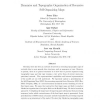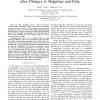701 search results - page 4 / 141 » The Rufus System: Information Organization for Semi-Structur... |
NECO
2006
13 years 7 months ago
2006
Recently, there has been an outburst of interest in extending topographic maps of vectorial data to more general data structures, such as sequences or trees. However, at present, ...
ICDE
2012
IEEE
11 years 10 months ago
2012
IEEE
—A major challenge faced by today’s information systems is that of evolution as data usage evolves or new data resources become available. Modern organizations sometimes exchan...
CHI
2002
ACM
14 years 8 months ago
2002
ACM
The task of organizing information is typically performed either by physically manipulating note cards or sticky notes or by arranging icons on a computer with a graphical user in...
DGO
2007
13 years 9 months ago
2007
Solving complex global problems such as illegal immigration, border control, and terrorism requires government organizations at all levels to share not only data but, more importa...
DEXAW
2005
IEEE
14 years 1 months ago
2005
IEEE
Data mining (DM) is still a technology having great expectations to enable organizations to take more benefit of their huge databases. There exist some success stories where organ...


